Fishing KnotsBasic fly fishing knots for all situations - illustrated instructions on how to tie some of the best and most popular fishing knots, fly fishing knots in particular, linking reel to backing to fly line to leader to fly. |
| |||
| In fly fishing, as in all fishing, the knot the fisherman uses is crucial to success, as many of us have learned to our cost. It is important to get our fishing knots right, in securing our backing line to the reel; in connecting our backing line to the fly line; in joining our fly line to our leader; and in tying on our fly. A number of the most reliable fly fishing knots are illustrated below. These are the fishing knots I use in my salmon, trout and sea trout fly fishing. These knots are simple, strong and reliable and include some of the most popular fly fishing knots in use today, such as the Perfection Loop and the Water Knot, as well as one or two not so well known knots, such as Gray's Loop. For those who like to attach their leader to the fly line by a loop-to-loop connection, Gray's Loop, shown above, is a simple, neat, strong, and durable alternative to the braided loop. | ||||
| | ||||
Fly Fishing Knots |
REEL > BACKING LINE > FLY LINE > LEADER > DROPPER > FLY
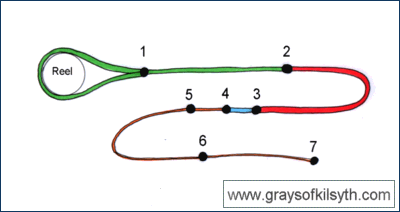
3 - Gray's Loop
4 - Loop to Loop
5 - Perfection Loop
6 - Water Knot
7 - Slip Knot
SLIP KNOT - Backing to reel
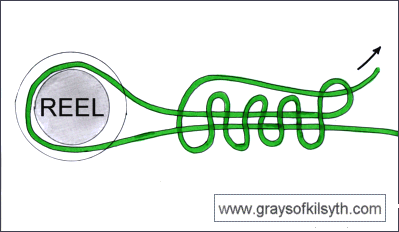 | SLIP KNOTA reliable knot for attaching backing line to the reel.For full tying instructions see Fly Fishing Knots |
CONSTRICTION KNOT - Backing to Fly line
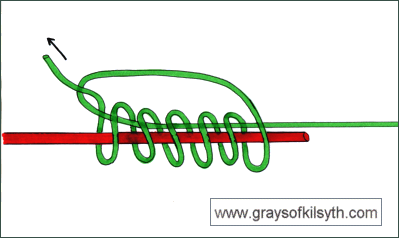 | CONSTRICTION KNOTThis knot is suitable for attaching nylon monofilament, dacron, braided terylene or twisted nylon backing to a traditional PVC coated, terylene core fly line. It is not suitable for some modern lines with kevlar or monofilament cores. Nor should it be used with hollow braided nylon backing line. For full tying instructions see:Fly Fishing Knots |
GRAY'S LOOP - Fly line Butt Loop
See also Needle knot version of GRAY'S LOOP - tying method with photographs.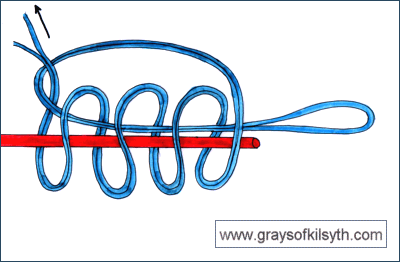 | GRAY'S LOOPA version of the Constriction knot for attaching a semi-permanent loop of nylon monofilament to the end of a traditional PVC coated, terylene core flyline to facilitate a loop to loop connection with the leader. Such a loop might last a whole season.For full illustrated instructions on the tying method, see Gray's Loop |
 | |
| See Needle knot version of GRAY'S LOOP |
LOOP TO LOOP - Butt Loop to Leader
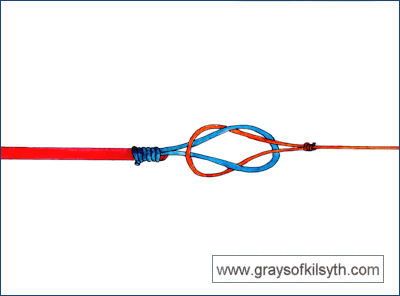 | LOOP TO LOOPA convenient method of attaching a leader to the fly line, avoiding wear and tear on the butt loop.For full tying instructions see Fly Fishing Knots |
PERFECTION LOOP - Leader (or cast) Loop
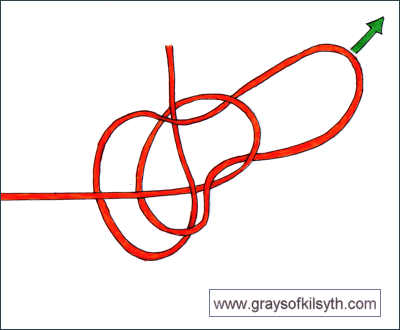 | PERFECTION LOOPA reliable leader loop which lies in line with the leader. The loose end can be trimmed very close to the knot. Easier to tie than it looks.For full tying instructions see Fly Fishing Knots |
WATER KNOT - Dropper Knot
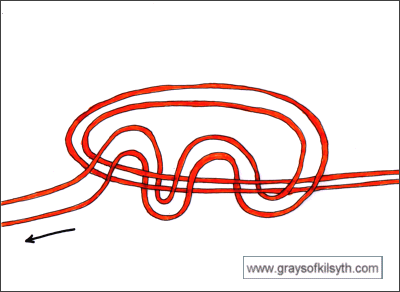 | WATER KNOTA good dropper knot. Stronger, more reliable and easier to tie than the blood knot. Although the typical advice is for three turns, I often use only two turns and the resultant knot seems quite reliable. Note that the length used for the dropper should be the one pointing away from the reelFor full tying instructions see Fly Fishing Knots |
SLIP KNOT - Fly or Hook connection
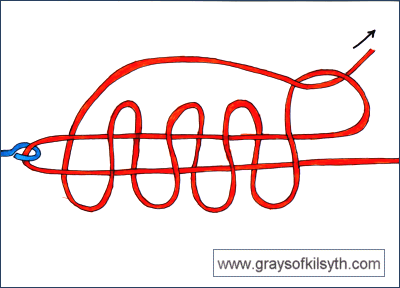 | SLIP KNOTAn alternative to the half - blood knot which has served me well for over thirty years. Similar to the Grinner knot. Tighten well and don't trim too close to the hook.For full tying instructions see Fly Fishing Knots |

 Trout is available all year round from supermarkets, individual shops, fishmongers or direct from fish-farm shops. It can be purchased fresh or frozen, as fillets, steaks or whole fish and also comes in hot and cold smoked varieties. Trout is low in both fat (a third of the fat of salmon) and calories (just 135kcals per 100g), with high levels of A and B vitamins, calcium, selenium and the vital Omega-3. It is also quick and easy to cook, as well as being very versatile:
Trout is available all year round from supermarkets, individual shops, fishmongers or direct from fish-farm shops. It can be purchased fresh or frozen, as fillets, steaks or whole fish and also comes in hot and cold smoked varieties. Trout is low in both fat (a third of the fat of salmon) and calories (just 135kcals per 100g), with high levels of A and B vitamins, calcium, selenium and the vital Omega-3. It is also quick and easy to cook, as well as being very versatile:

























